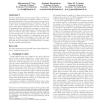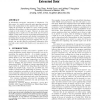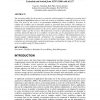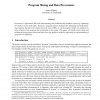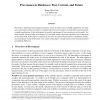ER
2010
Springer
13 years 10 months ago
2010
Springer
: Data provenance is becoming increasingly important for biosciences with the advent of large-scale collaborative environments such as the iPlant collaborative, where scientists co...
DMSN
2010
ACM
13 years 10 months ago
2010
ACM
E-science applications use fine grained data provenance to maintain the reproducibility of scientific results, i.e., for each processed data tuple, the source data used to proce...
PVLDB
2008
13 years 11 months ago
2008
In information extraction, uncertainty is ubiquitous. For this reason, it is useful to provide users querying extracted data with explanations for the answers they receive. Provid...
CONCURRENCY
2008
13 years 11 months ago
2008
ce that allows navigation from an abstract model of the experiment to instance data collected during a specific experiment run. We outline modest extensions to a commercial workflo...
SIGMOD
2008
ACM
13 years 11 months ago
2008
ACM
Provenance in the context of workflows, both for the data they derive and for their specification, is an essential component to allow for result reproducibility, sharing, and know...
JWSR
2008
13 years 11 months ago
2008
: The increasing ability for the sciences to sense the world around us is resulting in a growing need for data driven applications that are under the control of workflows composed ...
DEBU
2007
13 years 11 months ago
2007
Provenance is information that aids understanding and troubleshooting database queries by explaining the results in terms of the input. Slicing is a program analysis technique for...
DEBU
2007
13 years 11 months ago
2007
The importance of maintaining provenance has been widely recognized, particularly with respect to highly-manipulated data. However, there are few deployed databases that provide p...
DEBU
2007
13 years 11 months ago
2007
The need to understand and manage provenance arises in almost every scientific application. In many cases, information about provenance constitutes the proof of correctness of re...
EXPERT
2006
13 years 12 months ago
2006
Agent-oriented cooperation techniques and standardized electronic healthcare record exchange protocols can be used to combine information regarding different facets of a therapy re...

